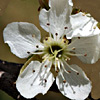Prunus ursina (Bear’s plum) is a winter-deciduous tree. It reaches a height of 3 meters. It is among the ancestors of the domesticated plum. The tree has a dense and branched structure. Some of the lateral branches develop into thorns. The trunk is twisted. The young branches are pilose. The appearance and distribution of groups of these trees indicate that it spreads, among others, by vegetative reproduction.
The leaf is simple, pilose, somewhat leathery, dentate. It is shorter and broader than the leaf of its relatives, the almond and the pear. Its width is about half of its length. Its upper side is glabrous, its lower side is pilose, which imparts it with a green-grayish appearance.
The name indicates that it was common in Europe, since its fruit serves as a component in the nutrition of bears during the fruit season (or because it is only fit for consumption by bears?).
Bear’s plum blooms in the spring, before or together with sprouting of the leaves. The bloom is white and plentiful, similar to that of its relative, the almond. Its general color is a little cloudier. The flower has 5 white to pink petals. The length of the petal is 6-10 mm, and it is clearly divided into a claw and a blade. The flower has 15 to 20 stamens. Pollination is solely mutual, by bees.
The fruit ripens in the summer. It is tasty, not especially high quality and is edible only during the short period between its ripening (before then it is astringent) and its rapid decomposition. It is a spherical drupe, with a diameter of 2-3 cm, yellow-reddish in color. The pulp is fleshy with a sweet-sour taste. The stone is smooth and contains a single seed.
Bear’s plum grows in Maquis and their remains in the Upper Galilee, the Golan Heights and Mount Hermon. Its global distribution spreads over the countries of the eastern Mediterranean Sea. The genus contains 35 species, which are common mainly in northern temperate regions.
Written by Mike Livne





